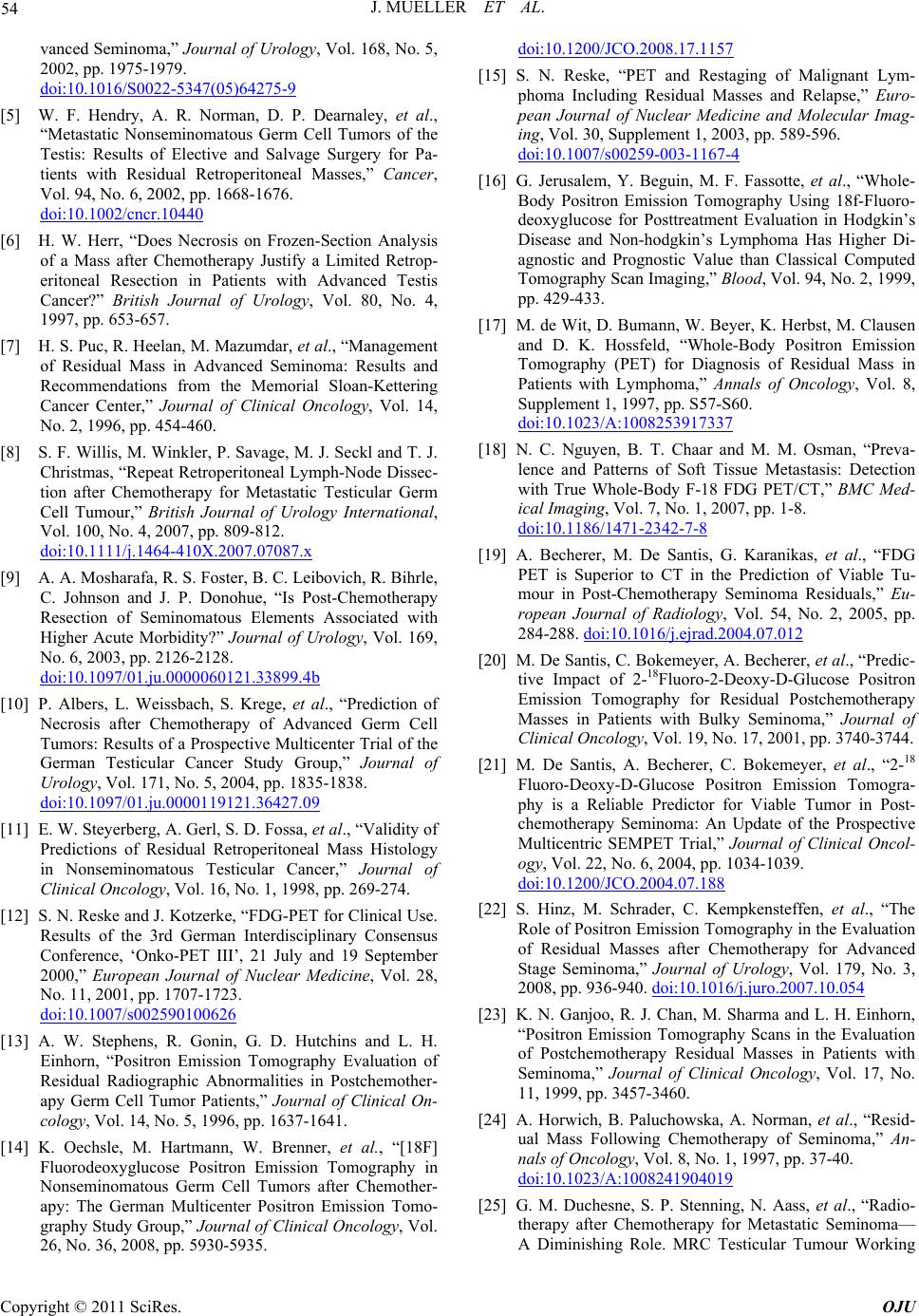
54 J. MUELLER ET AL.
vanced Seminoma,” Journal of Urology, Vol. 168, No. 5,
2002, pp. 1975-1979.
doi:10.1016/S0022-5347(05)64275-9
[5] W. F. Hendry, A. R. Norman, D. P. Dearnaley, et al.,
“Metastatic Nonseminomatous Germ Cell Tumors of the
Testis: Results of Elective and Salvage Surgery for Pa-
tients with Residual Retroperitoneal Masses,” Cancer,
Vol. 94, No. 6, 2002, pp. 1668-1676.
doi:10.1002/cncr.10440
[6] H. W. Herr, “Does Necrosis on Frozen-Section Analysis
of a Mass after Chemotherapy Justify a Limited Retrop-
eritoneal Resection in Patients with Advanced Testis
Cancer?” British Journal of Urology, Vol. 80, No. 4,
1997, pp. 653-657.
[7] H. S. Puc, R. Heelan, M. Mazumdar, et al., “Management
of Residual Mass in Advanced Seminoma: Results and
Recommendations from the Memorial Sloan-Kettering
Cancer Center,” Journal of Clinical Oncology, Vol. 14,
No. 2, 1996, pp. 454-460.
[8] S. F. Willis, M. Winkler, P. Savage, M. J. Seckl and T. J.
Christmas, “Repeat Retroperitoneal Lymph-Node Dissec-
tion after Chemotherapy for Metastatic Testicular Germ
Cell Tumour,” British Journal of Urology International,
Vol. 100, No. 4, 2007, pp. 809-812.
doi:10.1111/j.1464-410X.2007.07087.x
[9] A. A. Mosharafa, R. S. Foster, B. C. Leibovich, R. Bihrle,
C. Johnson and J. P. Donohue, “Is Post-Chemotherapy
Resection of Seminomatous Elements Associated with
Higher Acute Morbidity?” Journal of Urology, Vol. 169,
No. 6, 2003, pp. 2126-2128.
doi:10.1097/01.ju.0000060121.33899.4b
[10] P. Albers, L. Weissbach, S. Krege, et al., “Prediction of
Necrosis after Chemotherapy of Advanced Germ Cell
Tumors: Results of a Prospective Multicenter Trial of the
German Testicular Cancer Study Group,” Journal of
Urology, Vol. 171, No. 5, 2004, pp. 1835-1838.
doi:10.1097/01.ju.0000119121.36427.09
[11] E. W. Steyerberg, A. Gerl, S. D. Fossa, et al., “Validity of
Predictions of Residual Retroperitoneal Mass Histology
in Nonseminomatous Testicular Cancer,” Journal of
Clinical Oncology, Vol. 16, No. 1, 1998, pp. 269-274.
[12] S. N. Reske and J. Kotzerke, “FDG-PET for Clinical Use.
Results of the 3rd German Interdisciplinary Consensus
Conference, ‘Onko-PET III’, 21 July and 19 September
2000,” European Journal of Nuclear Medicine, Vol. 28,
No. 11, 2001, pp. 1707-1723.
doi:10.1007/s002590100626
[13] A. W. Stephens, R. Gonin, G. D. Hutchins and L. H.
Einhorn, “Positron Emission Tomography Evaluation of
Residual Radiographic Abnormalities in Postchemother-
apy Germ Cell Tumor Patients,” Journal of Clinical On-
cology, Vol. 14, No. 5, 1996, pp. 1637-1641.
[14] K. Oechsle, M. Hartmann, W. Brenner, et al., “[18F]
Fluorodeoxyglucose Positron Emission Tomography in
Nonseminomatous Germ Cell Tumors after Chemother-
apy: The German Multicenter Positron Emission Tomo-
graphy Study Group,” Journal of Clinical Oncology, Vol.
26, No. 36, 2008, pp. 5930-5935.
doi:10.1200/JCO.2008.17.1157
[15] S. N. Reske, “PET and Restaging of Malignant Lym-
phoma Including Residual Masses and Relapse,” Euro-
pean Journal of Nuclear Medicine and Molecular Imag-
ing, Vol. 30, Supplement 1, 2003, pp. 589-596.
doi:10.1007/s00259-003-1167-4
[16] G. Jerusalem, Y. Beguin, M. F. Fassotte, et al., “Whole-
Body Positron Emission Tomography Using 18f-Fluoro-
deoxyglucose for Posttreatment Evaluation in Hodgkin’s
Disease and Non-hodgkin’s Lymphoma Has Higher Di-
agnostic and Prognostic Value than Classical Computed
Tomography Scan Imaging,” Blood, Vol. 94, No. 2, 1999,
pp. 429-433.
[17] M. de Wit, D. Bumann, W. Beyer, K. Herbst, M. Clausen
and D. K. Hossfeld, “Whole-Body Positron Emission
Tomography (PET) for Diagnosis of Residual Mass in
Patients with Lymphoma,” Annals of Oncology, Vol. 8,
Supplement 1, 1997, pp. S57-S60.
doi:10.1023/A:1008253917337
[18] N. C. Nguyen, B. T. Chaar and M. M. Osman, “Preva-
lence and Patterns of Soft Tissue Metastasis: Detection
with True Whole-Body F-18 FDG PET/CT,” BMC Med-
ical Imaging, Vol. 7, No. 1, 2007, pp. 1-8.
doi:10.1186/1471-2342-7-8
[19] A. Becherer, M. De Santis, G. Karanikas, et al., “FDG
PET is Superior to CT in the Prediction of Viable Tu-
mour in Post-Chemotherapy Seminoma Residuals,” Eu-
ropean Journal of Radiology, Vol. 54, No. 2, 2005, pp.
284-288. doi:10.1016/j.ejrad.2004.07.012
[20] M. De Santis, C. Bokemeyer, A. Becherer, et al., “Predic-
tive Impact of 2-18Fluoro-2-Deoxy-D-Glucose Positron
Emission Tomography for Residual Postchemotherapy
Masses in Patients with Bulky Seminoma,” Journal of
Clinical Oncology, Vol. 19, No. 17, 2001, pp. 3740-3744.
[21] M. De Santis, A. Becherer, C. Bokemeyer, et al., “2-18
Fluoro-Deoxy-D-Glucose Positron Emission Tomogra-
phy is a Reliable Predictor for Viable Tumor in Post-
chemotherapy Seminoma: An Update of the Prospective
Multicentric SEMPET Trial,” Journal of Clinical Oncol-
ogy, Vol. 22, No. 6, 2004, pp. 1034-1039.
doi:10.1200/JCO.2004.07.188
[22] S. Hinz, M. Schrader, C. Kempkensteffen, et al., “The
Role of Positron Emission Tomography in the Evaluation
of Residual Masses after Chemotherapy for Advanced
Stage Seminoma,” Journal of Urology, Vol. 179, No. 3,
2008, pp. 936-940. doi:10.1016/j.juro.2007.10.054
[23] K. N. Ganjoo, R. J. Chan, M. Sharma and L. H. Einhorn,
“Positron Emission Tomography Scans in the Evaluation
of Postchemotherapy Residual Masses in Patients with
Seminoma,” Journal of Clinical Oncology, Vol. 17, No.
11, 1999, pp. 3457-3460.
[24] A. Horwich, B. Paluchowska, A. Norman, et al., “Resid-
ual Mass Following Chemotherapy of Seminoma,” An-
nals of Oncology, Vol. 8, No. 1, 1997, pp. 37-40.
doi:10.1023/A:1008241904019
[25] G. M. Duchesne, S. P. Stenning, N. Aass, et al., “Radio-
therapy after Chemotherapy for Metastatic Seminoma—
A Diminishing Role. MRC Testicular Tumour Working
Copyright © 2011 SciRes. OJU